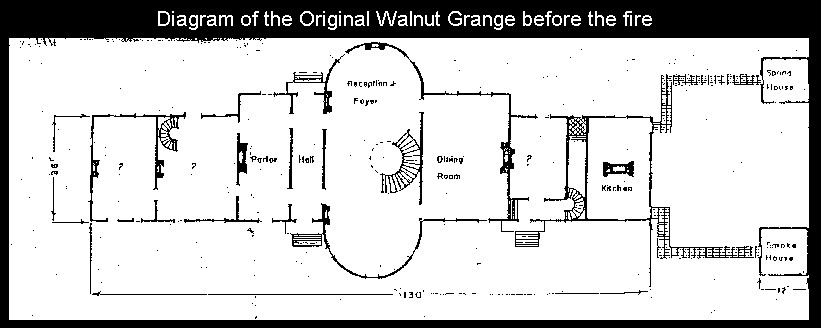|

Building 209, BARC-East currently houses the Animal and Natural Resources Institute (ANRI), Director's Office and is most commonly referred to as "Walnut Grange".

Click on the diagram to enlarge.
"The Butterfly House", by Albert Blasco 12.25.1980
With the changing times, we are lucky to have a few historical landmarks left at the Beltsville Agricultural Research Center. One of these is Walnut Grange or "The Butterfly House."
If you travel east on Powder Mill Road, you will see the large white house on the left perched on one of the highest promontories in the area. The western part of the house has semi-circular or cylindrical walls.
Walnut Grange was built around the year 1790, according to information obtained from Miss Susie Beall, granddaughter of Richard Hall, who purchased the home in 1859 from the executors of Mary Snowden Herbert estate. It was the home of the Hall family until purchased by the Government.
Mary Snowden was one of five children of Major Thomas Snowden (1751-1803), who was son of Thomas (1722-1770) son of Richard Snowden II, the Ironmaster, first owner of Montpelier. This Richard was the son of Richard Snowden I, who received a grant of a manor from Lord Baltimore around the year 1660. It is said that during his lifetime he amassed an estate of 80,000 acres.
Mary Snowden has this two-story brick dwelling built on the tract of land she inherited from her father, Major Thomas Snowden. It was built about the time she married Col. Carlyle Herbert. It was named after his former home, Walnut Grange, in Virginia.
The present house is only part of the original. The west wing was destroyed by fire - date unknown. It has two floors and an attic of part of the house. It is about half the size of the original home, and the part which comprises the hall and two parlors was one large central hall. The rooms on either side of the large central hall extended to the east and to the west. It was truly a "Butterfly House" before it was burned. The brick with which it was built was brought from England on sailing ships as ballast.
This unusual semi-circular bay house was built with 18-inch walls, both interior and exterior. The main portion had a center hall dividing two parlors. One room was called the "winter parlor", which was smaller than the other. The larger room was called the "summer parlor." When constructed, the hall contained a beautiful spiral stairway that wound its way to the attic. This staircase has been replaced with the conventional type. Each room of this mansion contained a fireplace. The floors are of wide hard pine and the woodwork is plain and dignified.
Centered behind this hall, two large doors opened into a very large dining room. Beyond this area lies another room of smaller size backed up by two kitchens. From the kitchens, a short brick path led the way to a milk house and a meat house. Quarters for the slaves were off to the side of the milk house.
Massive oak trees and terraced gardens of superb English boxwood set off the beautiful mansion. People have traveled many miles to examine and admire the mansion.
Since being sold by the executors of Mary Snowden Herbert estate, this home has been owned by Richard Hall in 1865, then the United States Government in 1910.
At the time it was purchased by the Government, several slave quarters and a large brick bank bard were still standing from date of Herbert's ownership, and were in good condition. Richard Hall operated a blacksmith, wheelwright and harness-making shop while he lived here. A brick kiln was also in operation at this time. There still stands the old smokehouse and another small shed from the Herbert's days at Walnut Grange.
During the Hall's ownership, Mr. Hall conducted a private school. The building was located just north of the home. The teachers were two of Mrs. Hall's nieces, who had attended college in Pennsylvania.
We believed that, although the circular staircase is no longer here and the home is now a "One-Winged Butterfly House", these losses do not measurably detract from its beauty. However, one does have to stretch his imagination to some extent to replace some of the things that used to be here.
Since Walnut Grange has become the property of the Government, it has served as the residence of many Department of Agriculture employees. During this period the house was completely modernized to include an electrical kitchen, oil heat and three and a half bathrooms. The last USDA employee to occupy Walnut Grange as a resident was Mr. Charles Logan who retired in 1971. He and his family lived in the house for about thirty years. Walnut Grange remained empty for a short time and then was renovated slightly to become offices for the Division of Operations, BARC.
At this writing, Walnut Grange is occupied by Mr. Robert L. Almond Sr., Head Division of Operations his secretary Mrs. Joyce Olenik; Mr. Leon Pheder, Chief, Utilities and Services Branch; his secretary, Mrs. Gale Dupuis; Mr. Cissel Archer, Chief, Utilities Section; Mr. Albert Blasco, Safety and Health Manager, and his secretary, Mrs. Eleanor Griffith.
|